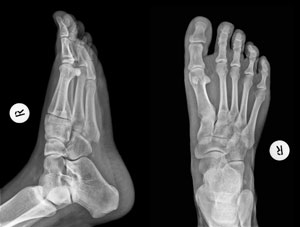Podiatry
Podiatry surgery focuses on the foot, ankle and related leg structures. When foot problems do not respond to conservative management, such as the services from our Foot Care Clinic, surgery may help alleviate discomfort to restore foot function.
 Conditions Treated
Conditions Treated
- Bunions
- Hammer Toe
- Plantar Fasciitis/Heel Spurs
- Achilles Tendon Tears
- Clubfoot
- Flatfoot/Cavus Foot Reconstruction
- Joint Dislocations
- Foot and Ankle Fractures
- Bone Tumors
- Foot/Ankle Arthritis
Types of Foot & Ankle Surgery
Bunion Surgery: There are many different types of bunion surgery depending on the severity of the bunion and the joint involvement. Your podiatrist can explain the bunion procedure that is most appropriate for your bunion. Depending on the surgery necessary, the recovery time can be very different, particularly if you need to be on crutches after the surgery or in a cast.
Debridement: Debridement surgically removes nonliving tissue from wounds to help speed the healing process.
Fusions: Fusions usually treat arthritic conditions of the foot and ankle. A fusion removes cartilage from a joint and joins two or more bones together so they do not move. Fusions can be done with screws, plates or pins or a combination of these.
Hammer Toe Surgery: Hammer toe surgery may involve removing part of the toe bone to realign the toe or could involve fusing the toe joint. In some cases, it may involve placing an implant in the toe to maintain realignment.
Heel Surgery: Based on a patient’s condition and disease type, heel surgery can provide pain relief and restore mobility. The procedure type is based on examination and usually consists of plantar fascia release, with or without heel spur excision. There have been various modifications and surgical enhancements regarding heel surgery. Your podiatrist will determine which method is best for you.
Metatarsal Surgery: Surgery on the lesser metatarsals is commonly performed to redistribute the weight bearing on the ball of the foot. In some severe cases, such as rheumatoid arthritis, surgery may involve removing the metatarsal heads (the bones in the ball of the foot area).
Neuroma Surgery: Neuroma surgery involves removing a benign enlargement of a nerve, usually between the metatarsal heads in the ball of the foot. This soft tissue surgery tends to have a shorter recovery time than bone procedures, but it leaves some residual numbness related to the removal of the piece of nerve tissue.
Reconstructive Surgery: Foot and ankle reconstructive surgery consists of complex surgical repairs necessary to regain function or stability, reduce pain, and/or prevent further deformity or disease. Reconstructive surgery may require any of the following: tendon repair/transfer, bone fusions, joint replacement, bone grafting, skin or soft tissue repair, tumor excision, amputation, and/or the osteotomy of bone (cutting of bones in a precise fashion). Bone screws, pins, wires, staples, and other fixation devices (both internal and external) and casts may be utilized to stabilize and repair bone in reconstructive procedures.
Tendon Surgery: Surgery on the tendons can repair tears, but it also may lengthen or shorten the tendon depending on the problem. In some cases, tendons may be re-routed to improve foot and ankle function.
Related Info
Watch & Learn
Dr. Ryan Prusa explains what plantar fasciitis is and the solutions available with Brookings Health System. Dr. Nephi Jones explains bunions and the surgical treatment available at Brookings Health System.
For more information on podiatry procedures performed at Brookings Health System, contact us at (605) 696-9000.
Available At:
System Providers:

Nephi Jones, DPM, FACFAS
- Podiatry
- Wound Care
- Orthopedics
- Sports Medicine
- Avera Medical Group Specialty Care
- Wound Center
- Brookings Hospital

Ryan Prusa, DPM
- Podiatry
- Orthopedics
- Sports Medicine
- Avera Medical Group Specialty Care
- Brookings Hospital

